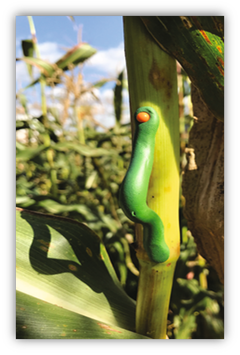|
Written by: Darsy Smith & Lindsay Barranco Destruction by crop insects requires strategies to combat pests below ground and above ground. Dr. Hiltpold’s novel approach uses nature to do this work.  Figure A. Imitation caterpillars were pinned on each depicted plant. The red arrow indicates a peck mark on the back of the caterpillar Photo credit: Dr. Ivan Hiltpold Figure A. Imitation caterpillars were pinned on each depicted plant. The red arrow indicates a peck mark on the back of the caterpillar Photo credit: Dr. Ivan Hiltpold How do we protect corn plants from pest insects? With the abundance of crop insect pests such as the larva of the western corn rootworm (WCR) (Coleoptera: Chrysomelidae) that feed primarily on corn roots in agricultural settings, how is it even possible for corn to make it to market for human consumption? Figuring out how to deter these insect pests has become Dr. Ivan Hiltpold’s research focus in different countries (Switzerland, United States) for nearly 15 years. Dr. Hiltpold described how his work has taken him on a journey beginning underground, then to ground level and then skyward. His overall focus is using plant chemistry to open new avenues to try to control pest insects in agricultural settings. Plants can produce volatile organic compounds (VOCs) as a chemical defense against herbivorous insects when the pests are feeding from a section of the plant (e.g. leaves, roots). In his “underground research” Dr. Hiltpold has looked at how VOCs produced by Bt plants with corn rootworm feeding damage attracted parasitic nematodes toward the plant’s damaged roots (Hiltpold & Hibbard, 2018). These nematodes are considered “entomopathogenic” which means that they are obligatory parasites of insects. The nematodes can cause death to the corn rootworm larvae by entering the corn root worm body, and releasing symbiotic bacteria, which then multiply and kill the insect pest by septicemia. The nematodes evaluated by Dr. Hiltpold are members of the genera Steinernema and Heterorhabditi and their symbiotic bacteria are Xenorhabdus and Photorhabdus, respectively. Prior to this study Dr. Hiltpold also evaluated a nematode encapsulation approach that lures the corn root worm by adding different attractants to the capsule shell encasing nematodes (Hiltpold & Hibbard (2013). This work demonstrated that these nematodes can be applied to combat pest insects such as the CRW in corn fields. Other major pest targeted by various commercial companies are listed here. In continuing his work in insect pest management, Dr Hiltpold looked skyward at bird predation as a means of crop pest control He has researched the way in which scavenger birds respond to plant VOCs - a first in an agricultural research setting (Hiltpold & Shriver, 2018). Previous studies on bird predation had primarily focused on the highly developed vision that birds rely on when foraging for insects as their main hunting cue. In order to test VOCs as hunting cues, researchers placed into a maize field numerous dispenser containing a synthetic blend of HIPV (herbivore-induced plant volatiles) alongside imitation clay caterpillars which served as “the lure” (Figure A). Dr. Hiltpold found that significantly more imitation caterpillars were attacked by birds when those caterpillars were placed close to the synthetic HIPV mix, compared to dispensers filled with only organic solvent. The clay caterpillars near the HIPV had seven times the number of bird peck marks (an indicator of bird predation) than the control group caterpillars that had been placed next to the organic solvent. This study concluded that insectivorous birds can respond to HIPV emitted from insect-damage maize and that birds can sense their environment based on olfaction cues. This is the first field study indicating that insect-eating birds respond to plant volatile compound cues emitted by plants, in an agricultural setting (Hiltpold & Shriver, 2018). About the Authors: Darsy Smith is a PhD student in the Lamp Lab at the University of Maryland. Lindsay Barranco is a MS student in the vanEngelsdorp Lab at the University of Maryland. Literature Cited: Hiltpold, I., & Hibbard, Bruce E., (2018). Indirect Root Defenses Cause Induced Fitness Costs in Bt-Resistant Western Corn Rootworm. Journal of Economic Entomology, 111(5), 2349-2358 Hiltpold, I., & Shriver, Gregory W., (2018). Birds Bug on Indirect Plant Defenses to Locate Insect Prey. Journal of Chemical Ecology (2018) 44: 576–579. Comments are closed.
|
Categories
All
Archives
June 2024
|
Department of Entomology
University of Maryland
4112 Plant Sciences Building
College Park, MD 20742-4454
USA
Telephone: 301.405.3911
Fax: 301.314.9290
University of Maryland
4112 Plant Sciences Building
College Park, MD 20742-4454
USA
Telephone: 301.405.3911
Fax: 301.314.9290

 RSS Feed
RSS Feed




